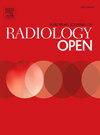冠状动脉脂肪衰减指数对急性冠状动脉综合征罪魁祸首病变的无创诊断价值
IF 2.9
Q3 RADIOLOGY, NUCLEAR MEDICINE & MEDICAL IMAGING
引用次数: 0
摘要
目的本研究旨在确定脂肪衰减指数(FAI)作为一种非侵入性诊断工具在诊断为急性冠脉综合征(ACS)的个体中精确识别罪魁祸首病变的有效性。方法对230例非st段抬高ACS患者进行回顾性分析。在每条主要冠状动脉近40mm段测量PCAT衰减(FAIstandard)。此外,确定病变的平均PCAT衰减被指定为FAIlesion。计算冠状动脉全长度的平均PCAT衰减,称为FAIaverage。通过冠状动脉ct血管造影分析斑块特征(体积、组成)。多变量逻辑回归确定了罪魁祸首病变的预测因素,并使用曲线下面积(AUC)和决策曲线分析评估了诊断效果。结果在FAIstandard、FAIaverage和FAIlesion参数中,sculprit病变的PCAT衰减水平均显著升高。与FAIstandard和FAIaverage相比,FAIlesion表现出更高的诊断准确性,并且也是最强的独立预测因子(优势比= 2.598,P <; 0.001)。在训练集和测试集中,将FAIlesion与其他指标相结合的复合模型对ACS患者的罪魁祸首病变的诊断效果增强(AUC = 0.960, 0.803)。低衰减斑块体积(<30 HU)与罪魁祸首病变独立相关(OR = 3.12, P = 0.002)。结论与传统FAI相比,failesion是一种更好的非侵入性ACS高危病变生物标志物,通过临床整合,可以更早地进行精确的风险分层。本文章由计算机程序翻译,如有差异,请以英文原文为准。
Non-invasive diagnostic value of pericoronary fat attenuation index for identifying culprit lesions in acute coronary syndrome
Objectives
This study aimed to determine the efficacy of fat attenuation index (FAI) as a non-invasive diagnostic tool in the precise identification of culprit lesions in individuals diagnosed with acute coronary syndrome (ACS).
Methods
A retrospective analysis of 230 patients with non-ST-segment elevation ACS. PCAT attenuation (FAIstandard) was measured in the proximal 40-mm segment of each major coronary artery. Furthermore, the average PCAT attenuation of the identified lesions was designated as FAIlesion. The average PCAT attenuation across the complete length of coronary artery, referred to as FAIaverage, was computed. Plaque characteristics (volume, composition) were analyzed via coronary computed tomography angiography. Multivariable logistic regression identified predictors of culprit lesions, and diagnostic performance was assessed using area under the curve (AUC) and decision curve analysis.
Results
Culprit lesions exhibited significantly elevated levels of PCAT attenuation across the parameters of FAIstandard, FAIaverage, and FAIlesion. FAIlesion demonstrated superior diagnostic accuracy versus FAIstandard and FAIaverage, and also emerged as the strongest independent predictor (Odds ratio = 2.598, P < 0.001). In training and test sets, a composite model integrating FAIlesion with additional indices demonstrated enhanced diagnostic efficacy for the detection of culprit lesions in patients with ACS (AUC = 0.960, 0.803). Low-attenuation plaque volume (<30 HU) was independently associated with culprit lesions (OR = 3.12, P = 0.002).
Conclusion
FAIlesion, a superior non-invasive biomarker for high-risk ACS lesions compared to traditional FAI, enables earlier precise risk stratification through clinical integration.
求助全文
通过发布文献求助,成功后即可免费获取论文全文。
去求助
来源期刊

European Journal of Radiology Open
Medicine-Radiology, Nuclear Medicine and Imaging
CiteScore
4.10
自引率
5.00%
发文量
55
审稿时长
51 days
 求助内容:
求助内容: 应助结果提醒方式:
应助结果提醒方式:


